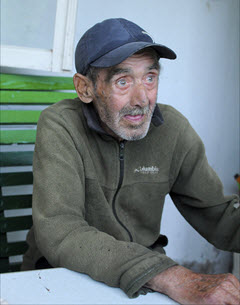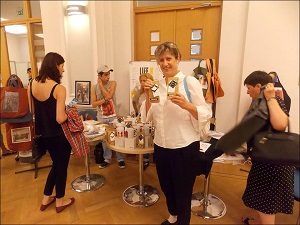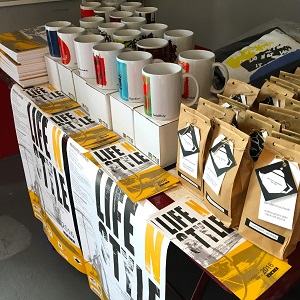Intrepid growers in a once-thriving tea region seek to revive artisan tea
NAGOMARI, Georgia
High in the fertile green hills of western Georgia, not far from the Turkish border, tea pluckers bend over their crops, picking leaves much the same way their grandfathers did when this entire region belonged to the Soviet Union.

Yuri Tsintsadze remembers those days well. A sweet-natured gentleman of 87, Tsintsadze labored in the tea industry for 70 years before retiring a few years ago.
“It’s a family tradition. Every village here has its own tea garden,” said tea grower Nana Kirmelashvili, speaking for the elder grower. “He spent his whole life in the tea business and then the USSR collapsed. Suddenly there was nothing left. It was a big disappointment. For us Georgians, it was horrible.”
Few foreigners to this former Soviet republic – less than half as big or populous as the U.S. state that shares its name – ever get to hear these stories. That’s because most tourists spend their time either in Tbilisi, the medieval Georgian capital packed with castles, museums and quaint little tea houses, or in the casinos and nightclubs of Batumi, the glitzy Black Sea resort located less than an hour’s drive west.
Kirmelashvili owns the Nagomari Tea House in Tbilisi as well as this hard-to-find tea plantation on the highway from Kutaisi to Batumi. A child of communism, she said tea pluckers today receive 2.20 lari (US$0.94) per kilo, up from one lari (US$0.43) two years ago. Workers pick 10–12 kilos of leaves per day, earning the equivalent of $11 – not bad for a farmworker in this land that gave birth to Stalin.
The fact that my group came to this obscure tea plantation at all, after an entire day driving from the Russian border checkpoint north of Kazbegi, is a testimony to our intrepid guide Elene Rakviashvili, whose visitors are usually more interested in vineyards than tea gardens.
Along the way, my colleagues from the Washington, D.C., area and I toured several wineries, explored the ruins of Christian Orthodox churches and inspected the so-called “administrative border” of barbed wire erected by the Russian military that separates Georgia from South Ossetia, one of its two breakaway republics (the other is Abkhazia, which was home to dozens of tea plantations that are now off-limits).
In fact, Georgia’s famous Saperavi, Tavkveri, and Rkatsiteli wine varietals are far better known to the world than its Gurieli or Nagomari tea brands. That’s because Georgia – which in the mid-1980s would have ranked as the world’s fourth-largest tea exporter, had it been an independent nation – sent all its tea to Moscow. Until the Soviet collapse in 1991, Georgia provided 95% of all the tea consumed by Russia, Ukraine, and the other 12 republics.
It’s also because Georgian tea just didn’t taste very good. Much like everything else in the communist system, the emphasis was on quantity, not quality. Tea was harvested by giant diesel-driven mechanical combines, not by hand.
It wasn’t always that way. Unlike Georgian wine, which has been produced for the last 8,000 years, tea cultivation dates back only to 1847, when the first tea bushes were planted in western Georgia. Decades later, a wealthy merchant named Konstantin Popov decided to grow tea for export along the Black Sea coast in Chakvi, a small town near Batumi in the province of Adjara.
Following an 1892 trip to China to study large-scale tea production, Popov brought back a team of Chinese workers led by Lao Junzhou of Guangdong. Lao spent years researching the crop and how to improve it. He eventually became the manager of a factory in 1901, and in 1924 the Soviet government awarded him the Red Banner Order of Labor for his efforts.
Despite a decline during the Khrushchev years in the 1960s, tea exports remained an important source of revenue for Georgia – especially the low-quality “Stalin tea” sold in 2 kg bricks for the equivalent of 60 cents to consumers in Mongolia.
But now, some eager Georgian entrepreneurs, like Kirmelashvili, are trying to change that.
“There is so much tea in the world and there are so many manufacturers like China and India. But we have a chance,” said Kirmelashvili, who has begun rehabilitating her 25-acre (10-hectare) farm with a $47,000 grant from the European Union’s ENPARD initiative.

At Nagomari, our group met technical manager Kakha Nachkebia. With Elene serving as our interpreter, the 42-year-old former electrician told us how the region’s soil is ideal for growing tea, as is its climate (the temperature drops to 27 °F (−3 °C) in winter) and its 3,675 foot altitude (1,120 meters) above sea level.
Nachkebia has been working in tea for the last 5 years. He said the plantation’s 33 employees harvested just over 1 metric ton of tea leaves last year, but that an expansion under way will boost that to 15 MT annually within a few years.
That’s a far cry from the 100,000 MT Georgia produced annually, said deputy agriculture minister Levan Davitashvili. “But the plantations were abandoned when the Soviet quota system fell apart, and there was no organization to look after them.”
Shortly after Georgia declared independence in 1991, the new country became embroiled in a civil war that killed thousands, crippled the economy and ravaged farms, explained Davitashvili. “At the same time, the market opened and we were no longer the only supplier of tea to the former Soviet Union. It was hard to compete with Sri Lanka and China. But the biggest problem is that during communism, nobody had any experience running a business in a market economy. So these companies suffered in the new environment. Right now, the tea plantations are in very poor condition.”
That was obvious as we drove along rutted roads, past ancient Soviet-built Lada automobiles and rusting tractors that looked as if they hadn’t been used in years.
Temuri Yakobashvili, Georgia’s former ambassador to the United States, is among the pessimists. He said his country’s tea industry was not a natural development, but very much a product of Soviet planning. “Some apparatchik in the Kremlin decided that Georgia was supposed to grow tea because the climate was appropriate,” he quipped. “Georgian tea had no free-market value because it had a guaranteed buyer.”
That hasn’t dissuade Irakli Gurchumelia, the owner of Bio Universal Georgia – a company formed in Armenia in 2007 by Gurchumelia’s business partner, Tigran Saakian.

Operating under the Manna Tea label, it produces eight types of herbal teas using leaves imported from Sri Lanka. Its Los Angeles division is known as Tanan Import Export Inc.
“Our target market is mainly Europe and the United States,” he said. “We don’t sell the tea in Georgia because everybody in Georgia drinks plain tea, not with herbs. And we know that organic tea is a little more expensive than ordinary teas.”
But come September, the company – which has already invested $500,000 to ramp up production and will spend another $300,000 next year – will start sourcing its teas from Guria in western Georgia; its products will be rebranded as Manna Artisan.
“Before, all the tea came from Sri Lanka and India,” he said. “Some herbs, like thyme, chamomile, and mint, we can buy in Georgia. The problem is that we produce organic and non-organic as well, and it’s quite difficult to get organic herbs in Georgia.”
I asked Gurchumelia if tea can really come back stronger than ever. “Maybe one day,” he said, “especially if the government continues giving additional grants.”
Meanwhile, the Nagomari Tea House in Tbilisi sells 50 g (1.75 oz) boxes of loose black tea for 7.50 lari (about US$3.40). It also offers green tea in a very limited edition.
And back on the farm, 87-year-old Yuri Tsintsadze spends his time reliving fond memories of the past – while busy making tea. “Yuri is one of the few old-timers who knows how to make handmade tea,” said Kirmelashvili. “He’s teaching the young people. We want this tradition to continue. It’s our only chance.”
Want to know what Georgian teas taste like? Read the informed tasting notes by our Director of Education, Suzette Hammond.
To discover more origin stories from the tea lands, subscribe to Tea Journey Magazine today.
1 thought on “Growers Hope to Revive Georgian Tea”